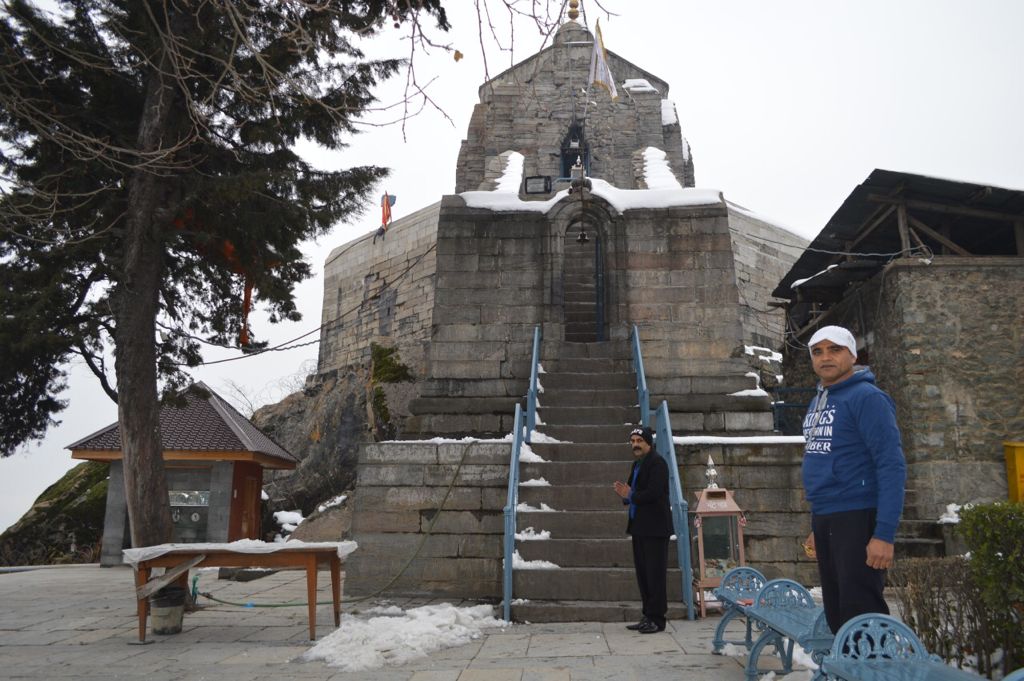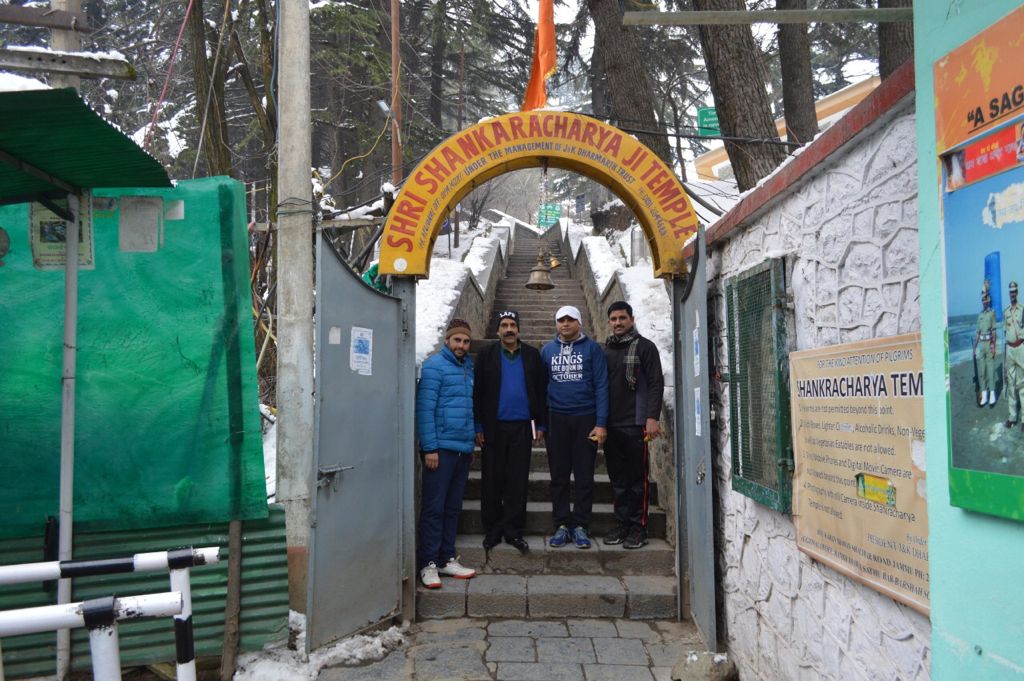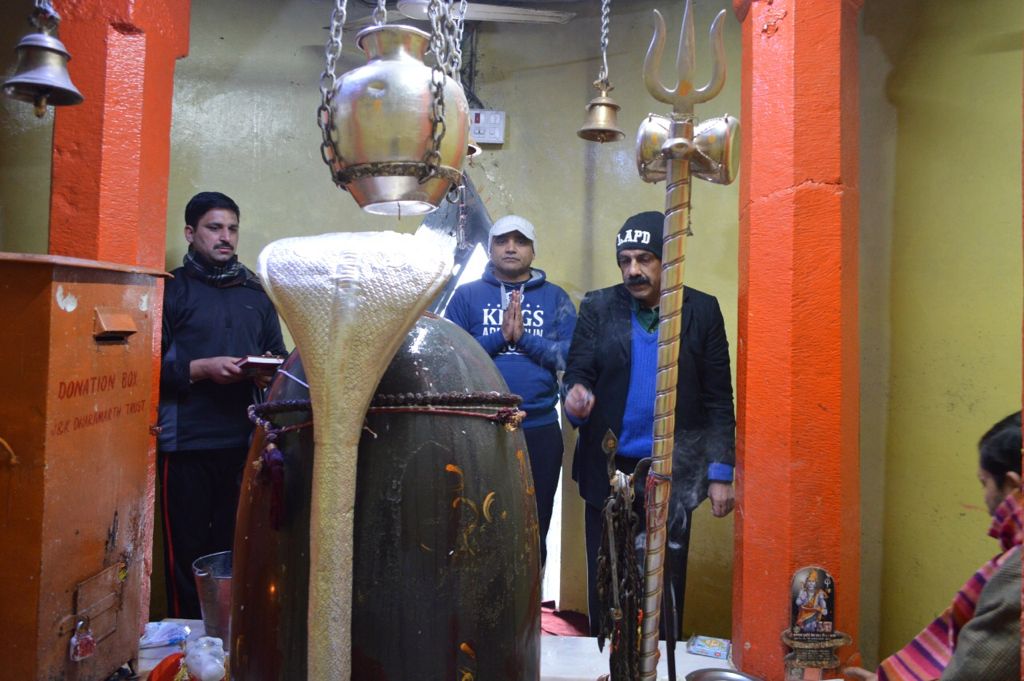
The other name of the temple is Jyeshtheswara temple; it is dedicated to Lord Shiva. Regular worship is being done here; however, Mahashivaratri in Phalgun and Shravan Amavasya are the two main festival days when large congregation is witnessed. The latter date is associated with the ritual of Chhari Mubaraq and integrated into Amarnath Yatra.
Location: The Shankaracharya Mandir is situated, some 335 metres above the ground level, atop a pyramid shaped hill of the same name located to the north-east of Srinagar City. The peak is called Takht-e-Sulaiman in the Moghul and British chronicles and forms a part of the Zabarwan range of sub-mountains between the Pir Panjal and the Greater Himalayas. Jhelum River flows on the south of the hill and the famous Dal Lake lies on its west. On the Jhelum side its foot is known as Gupkar area of the Srinagar where the residences of the elite of local administration and political figures are located. The foot-hill is accessible by a all-season mototrable road until the checkpoint of armed forces who guard the entrance of the temple at about 500 meters off.

Architecture: The Temple of Jyeshteswara is made of the dark bluish-gray crystalline schist stones, typical of the oldest strata of rocks which were formed in this region of Aryavarta. A staircase with 243 steps from the foot-hill leads to the twenty feet high octagonal stone basement of the temple which rests on the solid rock. The temple is designed as a square building: on each of the four sides are two projections which terminate in a pediment and a gable, the latter intersecting the main roof half-way up its slope.

The terrace surrounding the Temple is reached by a stone staircase of 10 steps encased between two walls, and a doorway, exactly opposite, leads to the small circular sanctum sanctorum. The ceiling of the interior chamber is supported by four octagonal columns, painted in orange, which surround a Basin containing a dark brown stone Lingam encircled by a snake. The outer terrace of the temple is broad enough allowing the visitors to stand over and enjoy a panoramic view of the city. A small dark chamber with very low ceiling is situated a few steps down the interior against the north-east facing wall of the octagonal temple. It houses the icon and symbols of Adi Shankaracharya and a space for meditation.

History:In the local tradition the temple is believed to be built by a king named Jhalokan. The sub-mountains of Kashmir valley,being en-route to Central Asia, were considered important by the traders, monks and Kushana kings, who all developed this place in the 3rd century BCE. Kashmir emerging as the principle seat of Shaivism in ancient times, this temple got patronage from the kings and philosophers alike. The temple is said to be renovated in the 7th century. Adi Shankaracharya visited here in the 9th century and composed Saundarya Lahari. Kalhan, the poet-cum-historiographer of the 12th century, has mentioned in his Rajataringini about the hill which was called Gopadri, being named after the local king Gopaditya.

The ancient name of the hill is still alive in the folk-memory as the Gupakar area, being a derivative of Gopa-agrahara, that is, the land donated by Gopaditya for temple priests! Koh-e-Suleman (the mount of Solomen), the Persian name of the Gopadri hill is mentioned in Aain-e -Akbari and it is said to be one of the favourite places of King Jahangir in Kashmir. In the royal accounts written during the later medieval period, the hill began to be called Takht-e-Sulaiman (the throne of Solomen). In the Survey of India Office, Calcutta report of March 1897 or in the Civil & Military Gazette published 1935 the name of the hill is described as Takht-i-Suleiman. Following the advent of the Sikh rule in Kashmir the shrine was repaired and a new Shivalingam was installed there during the governorship of Sheikh Ghulam Mohiuddin. During the British rule, a photograph of the Shankaracharya Temple on the summit of Takht-i-Suleiman was taken by John Burke in 1868. This view was reproduced in Henry Hardy Cole’s Archaeological Survey of India report of 1869, ‘Illustrations of Ancient Buildings in Kashmir.’ During the reign of Dogra Raja Gulab Singh (1846-1857) stairs were constructed and again Raja Pratap Singh (1885-1925) undertook renovation of the temple. The Raja of Mysore visited in 1925 and donated towards its electrification. Thus, all the rulers, irrespective of their faith, have patronized the shrine.

In 1961, while Bakshi Ghulam Mohammad was the Prime Minister, the Shankaracharya of Dwarika Peeth visited Kashmir and installed the image of Adi Shankaracharya at the temple. Shankaracharya temple has never been in any communal dispute during its long historical past. In fact, the local Muslim traders sell milk, flowers, incense sticks, etc. to Hindu pilgrims on way to the shrine and they welcome the traditional ritual of ‘Charri Mubarak’ when the holy mace of Lord Shiva is brought to the Shankaracharya temple on the Haryali Amavasya (of the Shravana month) that announces the commencement of Amarnath Yatra,

